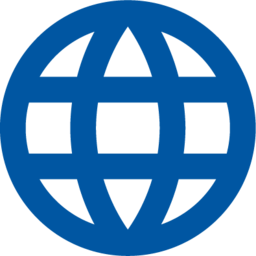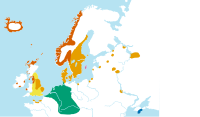 Global Information
Global InformationNorsemen information
| Part of a series on the |
| Norsemen |
|---|
 |
|
| WikiProject Norse history and culture |
This article needs additional citations for verification. (February 2024) |
The Norsemen (or Norse people) were a North Germanic linguistic group of the Early Middle Ages, during which they spoke the Old Norse language.[1][2][3][4] The language belongs to the North Germanic branch of the Indo-European languages and is the predecessor of the modern Germanic languages of Scandinavia.[4] During the late eighth century, Scandinavians embarked on a large-scale expansion in all directions, giving rise to the Viking Age. In English-language scholarship since the 19th century, Norse seafaring traders, settlers and warriors have commonly been referred to as Vikings. Historians of Anglo-Saxon England distinguish between Norse Vikings (Norsemen) from Norway, who mainly invaded and occupied the islands north and north-west of Britain, as well as Ireland and western Britain, and Danish Vikings, who principally invaded and occupied eastern Britain.[a]
Modern descendants of Norsemen include[5] the Danes, Icelanders,[b] Faroe Islanders,[b] Norwegians, and Swedes,[6] who are now generally referred to as "Scandinavians" rather than Norsemen.[7]
- ^ Fee, Christopher R. (2011). Mythology in the Middle Ages: Heroic Tales of Monsters, Magic, and Might: Heroic Tales of Monsters, Magic, and Might. ABC-CLIO. p. 3. ISBN 978-0313027253. Archived from the original on 17 January 2023. Retrieved 5 September 2019.
'Viking' is a term used to describe a certain class of marauding Scandinavian warrior from the 8th through the 11th century. However, when discussing the entire culture of the Northern Germanic peoples of the early Middle Ages, and especially in terms of the languages and literatures of these peoples, it would be more accurate to use the term 'Norse'. Therefore during the Middle Ages and beyond, it therefore might be useful to speak of 'German' peoples in middle Europe and of 'Norse' peoples in Scandinavia and the North Atlantic.
- ^ McTurk, Rory (2008). A Companion to Old Norse-Icelandic Literature and Culture. John Wiley & Sons. p. 7. ISBN 978-1405137386. Archived from the original on 17 January 2023. Retrieved 5 September 2019.
'Old Norse' defines the culture of Norway and Iceland during the Middle Ages. It is a somewhat illogical concept as it is largely synonymous with 'Norse' ... The term 'Norse' is often used as a translation of norroenn. As such it applies to all the Germanic peoples of Scandinavia and their colonies in the British Isles and the North Atlantic.
- ^ DeAngelo, Jeremy (2010). "The North and the Depiction of the 'Finnar' in the Icelandic Sagas". Scandinavian Studies. 82 (3): 257–286. doi:10.2307/25769033. JSTOR 25769033. S2CID 159972559.
The term 'Norse' will be used as a catchall term for all North Germanic peoples in the sagas ...
- ^ a b Leeming, David A. (2014). The Handy Mythology Answer Book. Visible Ink Press. p. 143. ISBN 978-1578595211.
Who were the Norse people? The term Norse is commonly applied to pre-Christian Northern Germanic peoples living in Scandinavia during the so-called Viking Age. Old Norse gradually developed into the North Germanic languages, including Icelandic, Danish, Norwegian, and Swedish.
- ^ Kristinsson, Axel (2010). Expansions: Competition and Conquest in Europe Since the Bronze Age. ReykjavíkurAkademían. ISBN 978-9979992219. Archived from the original on 17 January 2023. Retrieved 5 September 2019.
The same can be said of Viking Age Scandinavians who did not have a common ethnonym but expressed their common identity through the geographical and linguistic terms ... There is absolutely no doubt about a common Northern identity during the Viking Age and afterwards ... it even survives today.
- ^ Kennedy, Arthur Garfield (1963). "The Indo-European Language Family". In Lee, Donald Woodward (ed.). English Language Reader: Introductory Essays and Exercises. Dodd, Mead.
[T]he pages of history have been filled with accounts of various Germanic peoples that made excursions in search of better homes; the Goths went into the Danube valley and thence into Italy and southern France; and thence into Italy and southern France; the Franks seized what was later called France; the Vandals went down into Spain, and via Africa they 'vandalized' Rome; the Angles, part of the Saxons, and the Jutes moved over into England; and the Burgundians and the Lombards worked south into France and Italy. Probably very early during these centuries of migration the three outstanding groups of the Germanic peoples—the North Germanic people of Scandinavia, the East Germanic branch, comprising the Goths chiefly, and the West Germanic group, comprising the remaining Germanic tribes—developed their notable group traits. Then, while the East Germanic tribes (that is, the Goths) passed gradually out of the pages of history and disappeared completely, the North Germanic, or Scandinavian, or Norse, peoples, as they are variously called, became a distinctive people, more and more unlike the West Germanic folk who inhabited Germany itself and, ultimately, Holland, and Belgium and England. While that great migration of nations which the Germans have named the Volkerwanderung was going on, the Scandinavian division of the Germanic peoples had kept their habitation well to the north of the others and had been splitting up into the four subdivisions now known as the Swedes, Norwegians, Danes, and Icelanders. Long after the West Germanic and East Germanic peoples had made history farther south in Europe, the North Germanic tribes of Scandinavia began a series of expeditions which, during the eighth and ninth centuries, in the so-called Viking Age especially, led them to settle Iceland, to overrun England and even annex it to Denmark temporarily, and, most important of all, to settle in northern France and merge with the French to such an extent that Northmen became Normans, and later these Normans became the conquerors of England.
- ^ Davies, Norman (1999). The Isles: A History. Oxford University Press. ISBN 978-0198030737.
Ottar belonged to a group of peoples who were beginning to have a huge impact on European history. They are now called 'Scandinavians', though historically they were called 'Northmen'.
Cite error: There are <ref group=lower-alpha> tags or {{efn}} templates on this page, but the references will not show without a {{reflist|group=lower-alpha}} template or {{notelist}} template (see the help page).